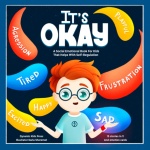Connecting and Identifying With Emotions
May 20, 2023
Quote of the Week
"One can be the master of what one does, but never of what one feels." - Gustave Flaubert
4 Big Emotions To Talk About With Little Kids
 "The different ways your child behaves actually stems from a list of four complex emotions. Here’s how explain them to your child in a way they’ll understand.
"The different ways your child behaves actually stems from a list of four complex emotions. Here’s how explain them to your child in a way they’ll understand.
Children as young as 1 start to show emotions, and whether they realize it or not, that's when caregivers started showing them back. Remember the time you told your little one, "Ouchie" and frowned when they threw that toy car? That's an emotion being displayed! "We implicitly identify, demonstrate, and explain why our toddlers shouldn't act a certain way by discussing and showing them the correct way,". But we often don't take the same time and effort to give those kinds of emotional cues to school-aged kids. "If you're just going to tell your child to go to her room when she misbehaves, you're missing an opportunity to discuss with her why she acted out and how she might be feeling," she adds. These small gestures can open the door to communication to help your child understand the complexities of emotions. [...]
However, when you are young you have no prior experiences to pull from—you react based on how you feel. "It's up to the parent or caregiver to train children in how to identify, name, interpret, and use their emotions. Then kids will learn a new language for self-expression," explains Gleicher. This language is one that doesn't stifle, shove down, repress, and then explode, but rather helps them understand why they are feeling what they are feeling. "The greatest gift you can give your kids is the ability to experience, recognize, and deal with emotions—it will be their key to resilience later in life," says Gleicher. [Read More]
Reading Corner
 Title: It’s Okay: A Social Emotional Book For Kids That Helps With Self-Regulation
Title: It’s Okay: A Social Emotional Book For Kids That Helps With Self-Regulation
By: Dynamic Kids Press
Ages: 5+
IT’S OKAY is a story of a kid Michael, a young boy with a big heart and even bigger emotions. The trouble is, keeping all his emotions under control isn’t always easy. Then Michael finds the strangest-looking watch he’s ever seen. It has no numbers and no dials, but it does contain an Emotion Master—a guide to his emotions and how to master them. Can Michael take the Emotion Master’s advice and learn how to deal with his emotions before he lets them get the better of him?
Fourteen short stories follow Michael’s story, offering readers choices on how to cope with their emotions in real-world situations, helping kids understand the power of choice.
Read these short stories and discuss with your child how a positive and a negative choice will shape their day.
By reading these short stories you’ll be able to empower kids to make positive choices while demonstrating the natural consequences of negative choices. - Publishers
Be the Change
Inspired by the article and the book suggestion this week, try and break down questions on emotions as suggested by the author. Just as the article suggests identify the feeling, explain the feeling, and talk about how to make it easier with your kids, and with yourself! If your children are younger, here's a fun little 'Feelings Video' that might trigger a starting point to talk about it too!





